Impact of Colonisation on Aboriginal and Torres Strait Islander Population and Marginalised People with Physical, Mental and Emotional Health Issues
VerifiedAdded on 2022/08/10
|10
|2351
|302
AI Summary
This article discusses the impact of colonisation on Aboriginal and Torres Strait Islander population and marginalised people with physical, mental and emotional health issues. It also highlights the protective factors for these groups of people.
Contribute Materials
Your contribution can guide someone’s learning journey. Share your
documents today.
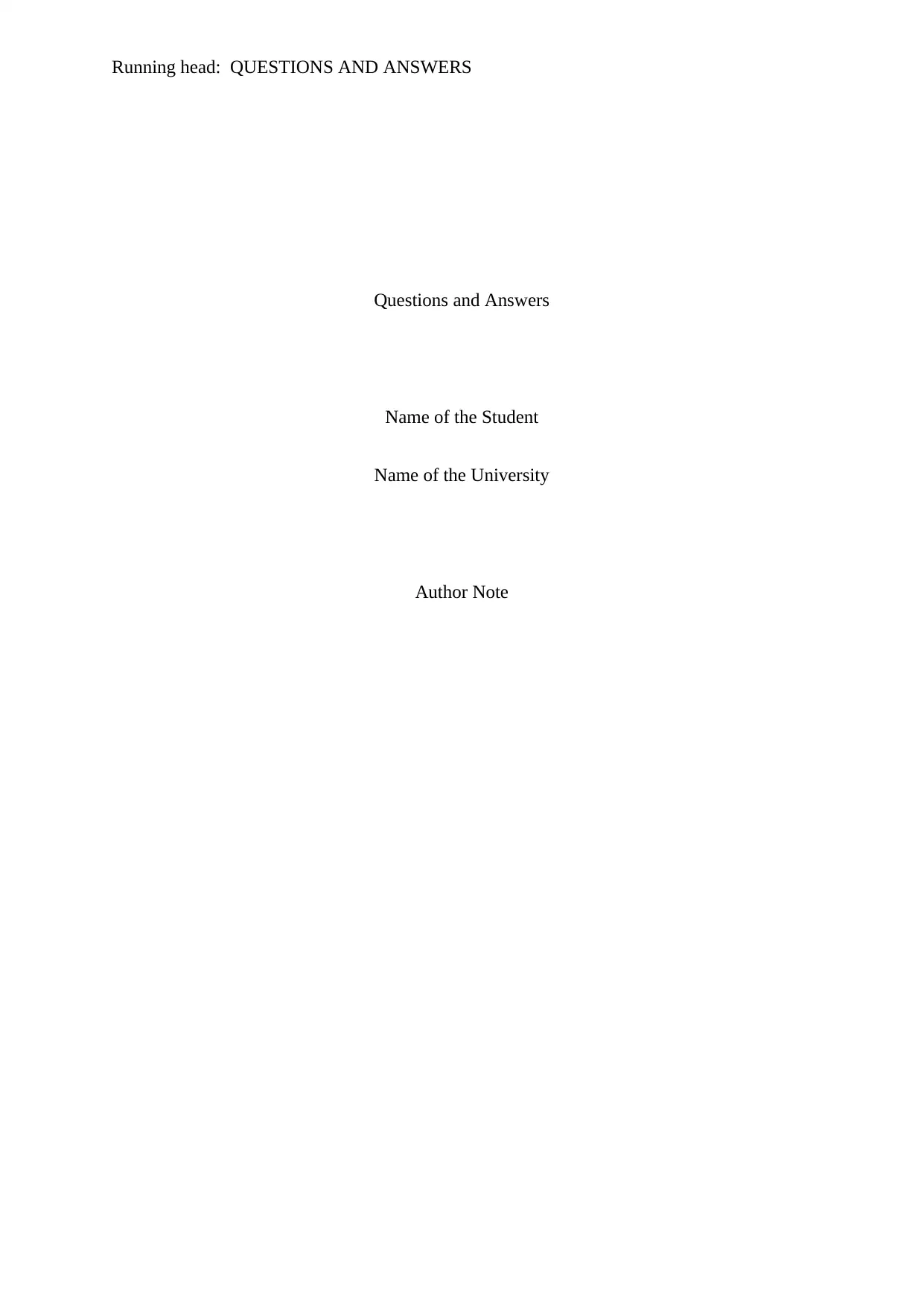
Running head: QUESTIONS AND ANSWERS
Questions and Answers
Name of the Student
Name of the University
Author Note
Questions and Answers
Name of the Student
Name of the University
Author Note
Secure Best Marks with AI Grader
Need help grading? Try our AI Grader for instant feedback on your assignments.
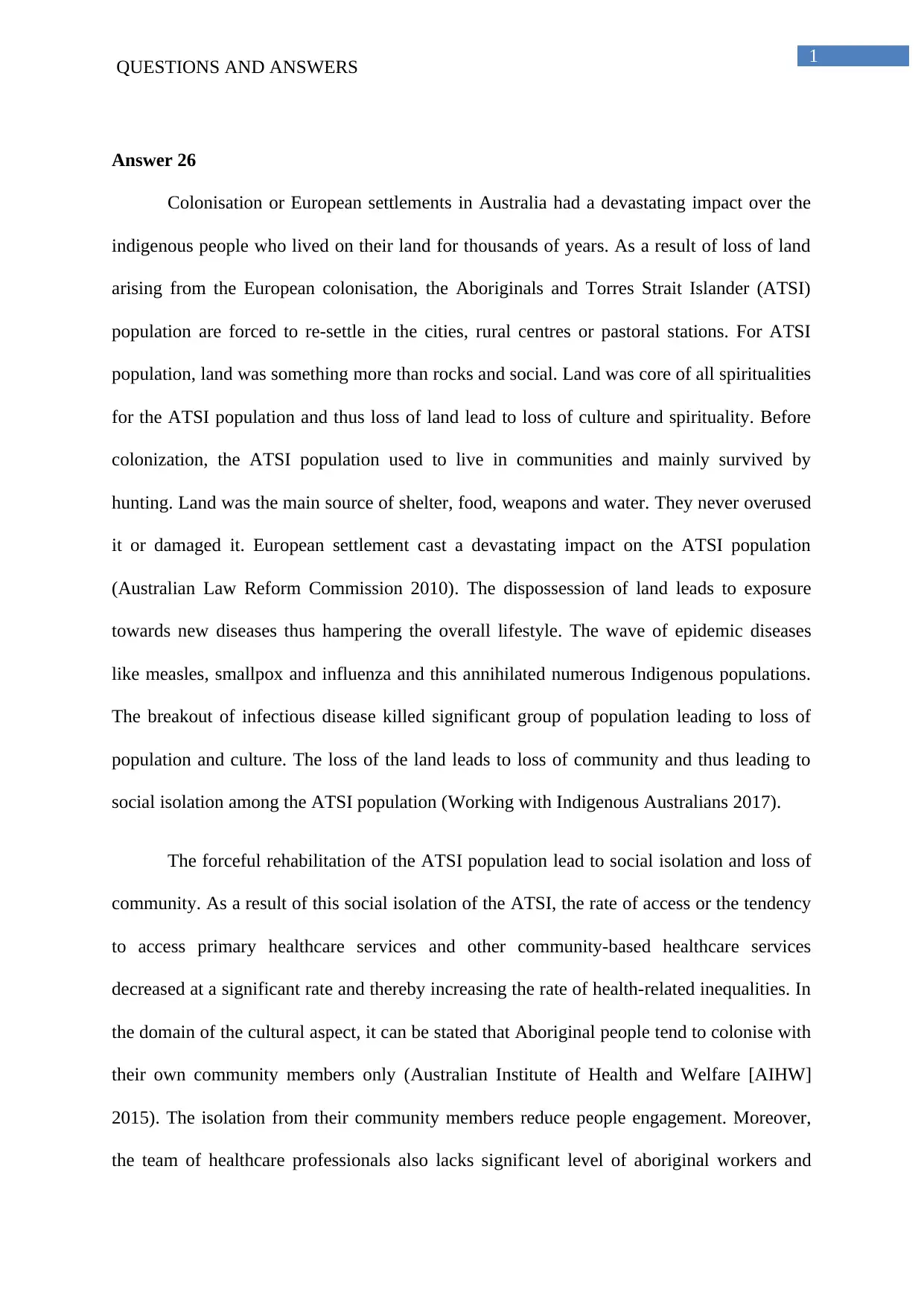
1
QUESTIONS AND ANSWERS
Answer 26
Colonisation or European settlements in Australia had a devastating impact over the
indigenous people who lived on their land for thousands of years. As a result of loss of land
arising from the European colonisation, the Aboriginals and Torres Strait Islander (ATSI)
population are forced to re-settle in the cities, rural centres or pastoral stations. For ATSI
population, land was something more than rocks and social. Land was core of all spiritualities
for the ATSI population and thus loss of land lead to loss of culture and spirituality. Before
colonization, the ATSI population used to live in communities and mainly survived by
hunting. Land was the main source of shelter, food, weapons and water. They never overused
it or damaged it. European settlement cast a devastating impact on the ATSI population
(Australian Law Reform Commission 2010). The dispossession of land leads to exposure
towards new diseases thus hampering the overall lifestyle. The wave of epidemic diseases
like measles, smallpox and influenza and this annihilated numerous Indigenous populations.
The breakout of infectious disease killed significant group of population leading to loss of
population and culture. The loss of the land leads to loss of community and thus leading to
social isolation among the ATSI population (Working with Indigenous Australians 2017).
The forceful rehabilitation of the ATSI population lead to social isolation and loss of
community. As a result of this social isolation of the ATSI, the rate of access or the tendency
to access primary healthcare services and other community-based healthcare services
decreased at a significant rate and thereby increasing the rate of health-related inequalities. In
the domain of the cultural aspect, it can be stated that Aboriginal people tend to colonise with
their own community members only (Australian Institute of Health and Welfare [AIHW]
2015). The isolation from their community members reduce people engagement. Moreover,
the team of healthcare professionals also lacks significant level of aboriginal workers and
QUESTIONS AND ANSWERS
Answer 26
Colonisation or European settlements in Australia had a devastating impact over the
indigenous people who lived on their land for thousands of years. As a result of loss of land
arising from the European colonisation, the Aboriginals and Torres Strait Islander (ATSI)
population are forced to re-settle in the cities, rural centres or pastoral stations. For ATSI
population, land was something more than rocks and social. Land was core of all spiritualities
for the ATSI population and thus loss of land lead to loss of culture and spirituality. Before
colonization, the ATSI population used to live in communities and mainly survived by
hunting. Land was the main source of shelter, food, weapons and water. They never overused
it or damaged it. European settlement cast a devastating impact on the ATSI population
(Australian Law Reform Commission 2010). The dispossession of land leads to exposure
towards new diseases thus hampering the overall lifestyle. The wave of epidemic diseases
like measles, smallpox and influenza and this annihilated numerous Indigenous populations.
The breakout of infectious disease killed significant group of population leading to loss of
population and culture. The loss of the land leads to loss of community and thus leading to
social isolation among the ATSI population (Working with Indigenous Australians 2017).
The forceful rehabilitation of the ATSI population lead to social isolation and loss of
community. As a result of this social isolation of the ATSI, the rate of access or the tendency
to access primary healthcare services and other community-based healthcare services
decreased at a significant rate and thereby increasing the rate of health-related inequalities. In
the domain of the cultural aspect, it can be stated that Aboriginal people tend to colonise with
their own community members only (Australian Institute of Health and Welfare [AIHW]
2015). The isolation from their community members reduce people engagement. Moreover,
the team of healthcare professionals also lacks significant level of aboriginal workers and
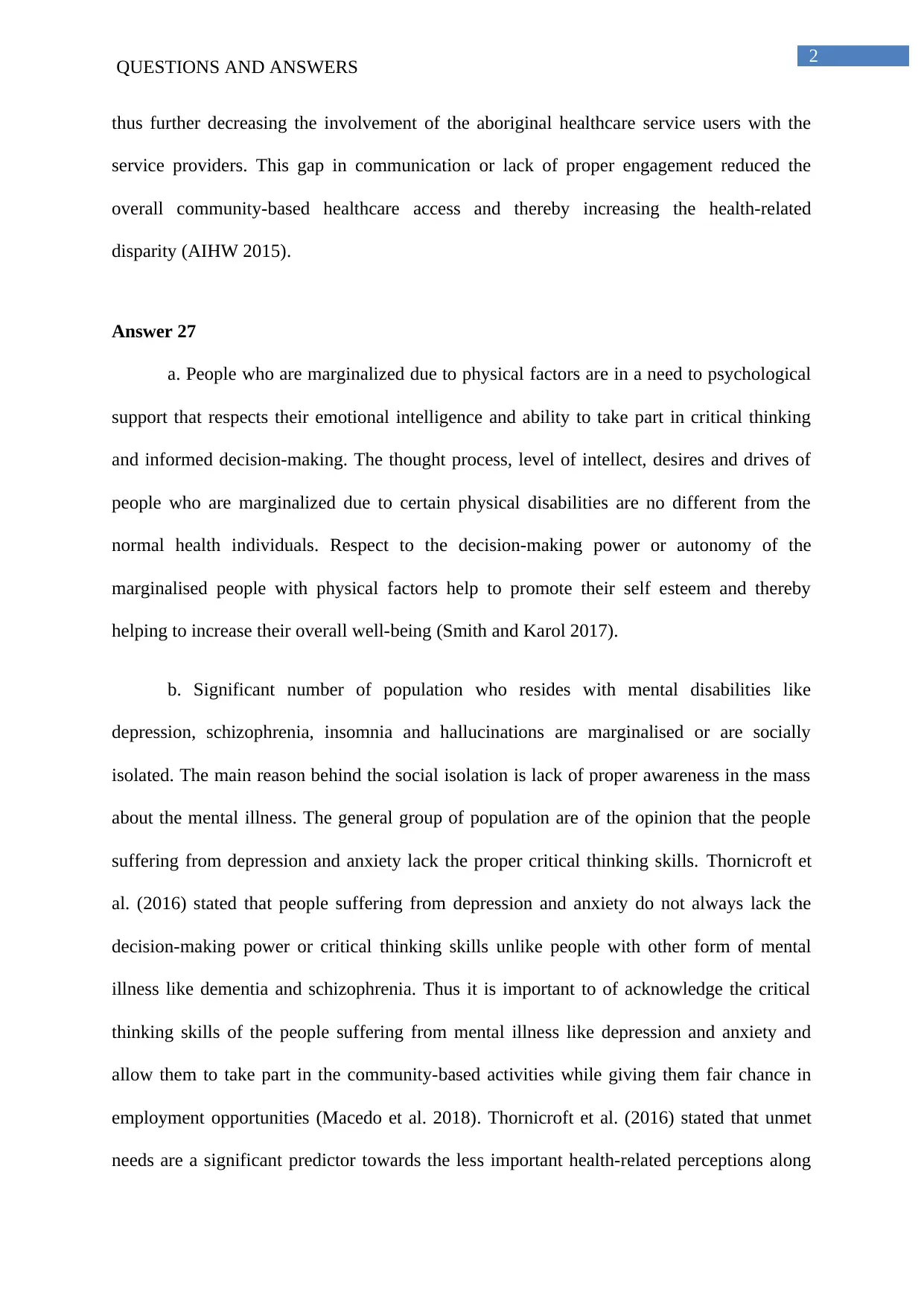
2
QUESTIONS AND ANSWERS
thus further decreasing the involvement of the aboriginal healthcare service users with the
service providers. This gap in communication or lack of proper engagement reduced the
overall community-based healthcare access and thereby increasing the health-related
disparity (AIHW 2015).
Answer 27
a. People who are marginalized due to physical factors are in a need to psychological
support that respects their emotional intelligence and ability to take part in critical thinking
and informed decision-making. The thought process, level of intellect, desires and drives of
people who are marginalized due to certain physical disabilities are no different from the
normal health individuals. Respect to the decision-making power or autonomy of the
marginalised people with physical factors help to promote their self esteem and thereby
helping to increase their overall well-being (Smith and Karol 2017).
b. Significant number of population who resides with mental disabilities like
depression, schizophrenia, insomnia and hallucinations are marginalised or are socially
isolated. The main reason behind the social isolation is lack of proper awareness in the mass
about the mental illness. The general group of population are of the opinion that the people
suffering from depression and anxiety lack the proper critical thinking skills. Thornicroft et
al. (2016) stated that people suffering from depression and anxiety do not always lack the
decision-making power or critical thinking skills unlike people with other form of mental
illness like dementia and schizophrenia. Thus it is important to of acknowledge the critical
thinking skills of the people suffering from mental illness like depression and anxiety and
allow them to take part in the community-based activities while giving them fair chance in
employment opportunities (Macedo et al. 2018). Thornicroft et al. (2016) stated that unmet
needs are a significant predictor towards the less important health-related perceptions along
QUESTIONS AND ANSWERS
thus further decreasing the involvement of the aboriginal healthcare service users with the
service providers. This gap in communication or lack of proper engagement reduced the
overall community-based healthcare access and thereby increasing the health-related
disparity (AIHW 2015).
Answer 27
a. People who are marginalized due to physical factors are in a need to psychological
support that respects their emotional intelligence and ability to take part in critical thinking
and informed decision-making. The thought process, level of intellect, desires and drives of
people who are marginalized due to certain physical disabilities are no different from the
normal health individuals. Respect to the decision-making power or autonomy of the
marginalised people with physical factors help to promote their self esteem and thereby
helping to increase their overall well-being (Smith and Karol 2017).
b. Significant number of population who resides with mental disabilities like
depression, schizophrenia, insomnia and hallucinations are marginalised or are socially
isolated. The main reason behind the social isolation is lack of proper awareness in the mass
about the mental illness. The general group of population are of the opinion that the people
suffering from depression and anxiety lack the proper critical thinking skills. Thornicroft et
al. (2016) stated that people suffering from depression and anxiety do not always lack the
decision-making power or critical thinking skills unlike people with other form of mental
illness like dementia and schizophrenia. Thus it is important to of acknowledge the critical
thinking skills of the people suffering from mental illness like depression and anxiety and
allow them to take part in the community-based activities while giving them fair chance in
employment opportunities (Macedo et al. 2018). Thornicroft et al. (2016) stated that unmet
needs are a significant predictor towards the less important health-related perceptions along
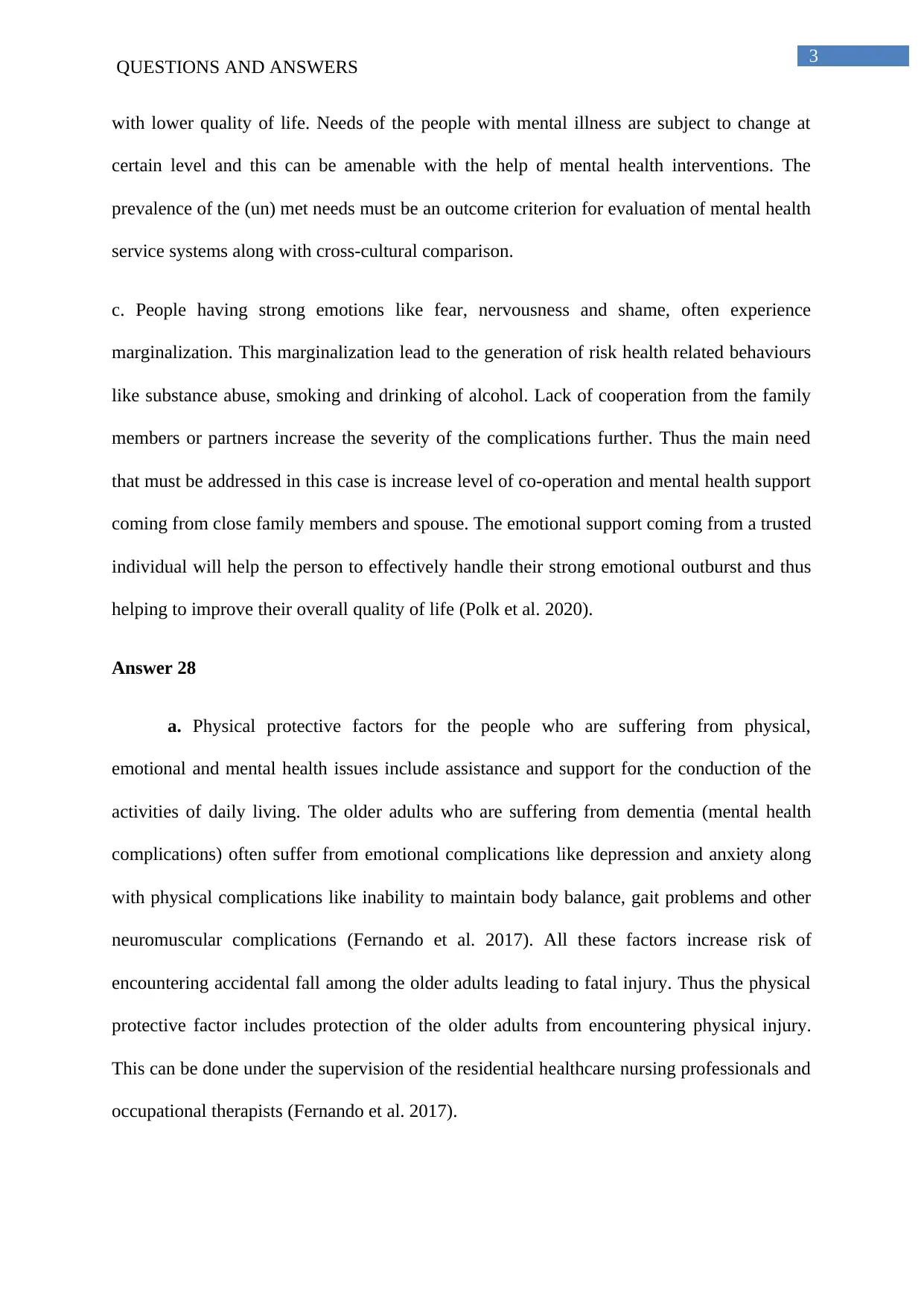
3
QUESTIONS AND ANSWERS
with lower quality of life. Needs of the people with mental illness are subject to change at
certain level and this can be amenable with the help of mental health interventions. The
prevalence of the (un) met needs must be an outcome criterion for evaluation of mental health
service systems along with cross-cultural comparison.
c. People having strong emotions like fear, nervousness and shame, often experience
marginalization. This marginalization lead to the generation of risk health related behaviours
like substance abuse, smoking and drinking of alcohol. Lack of cooperation from the family
members or partners increase the severity of the complications further. Thus the main need
that must be addressed in this case is increase level of co-operation and mental health support
coming from close family members and spouse. The emotional support coming from a trusted
individual will help the person to effectively handle their strong emotional outburst and thus
helping to improve their overall quality of life (Polk et al. 2020).
Answer 28
a. Physical protective factors for the people who are suffering from physical,
emotional and mental health issues include assistance and support for the conduction of the
activities of daily living. The older adults who are suffering from dementia (mental health
complications) often suffer from emotional complications like depression and anxiety along
with physical complications like inability to maintain body balance, gait problems and other
neuromuscular complications (Fernando et al. 2017). All these factors increase risk of
encountering accidental fall among the older adults leading to fatal injury. Thus the physical
protective factor includes protection of the older adults from encountering physical injury.
This can be done under the supervision of the residential healthcare nursing professionals and
occupational therapists (Fernando et al. 2017).
QUESTIONS AND ANSWERS
with lower quality of life. Needs of the people with mental illness are subject to change at
certain level and this can be amenable with the help of mental health interventions. The
prevalence of the (un) met needs must be an outcome criterion for evaluation of mental health
service systems along with cross-cultural comparison.
c. People having strong emotions like fear, nervousness and shame, often experience
marginalization. This marginalization lead to the generation of risk health related behaviours
like substance abuse, smoking and drinking of alcohol. Lack of cooperation from the family
members or partners increase the severity of the complications further. Thus the main need
that must be addressed in this case is increase level of co-operation and mental health support
coming from close family members and spouse. The emotional support coming from a trusted
individual will help the person to effectively handle their strong emotional outburst and thus
helping to improve their overall quality of life (Polk et al. 2020).
Answer 28
a. Physical protective factors for the people who are suffering from physical,
emotional and mental health issues include assistance and support for the conduction of the
activities of daily living. The older adults who are suffering from dementia (mental health
complications) often suffer from emotional complications like depression and anxiety along
with physical complications like inability to maintain body balance, gait problems and other
neuromuscular complications (Fernando et al. 2017). All these factors increase risk of
encountering accidental fall among the older adults leading to fatal injury. Thus the physical
protective factor includes protection of the older adults from encountering physical injury.
This can be done under the supervision of the residential healthcare nursing professionals and
occupational therapists (Fernando et al. 2017).
Secure Best Marks with AI Grader
Need help grading? Try our AI Grader for instant feedback on your assignments.
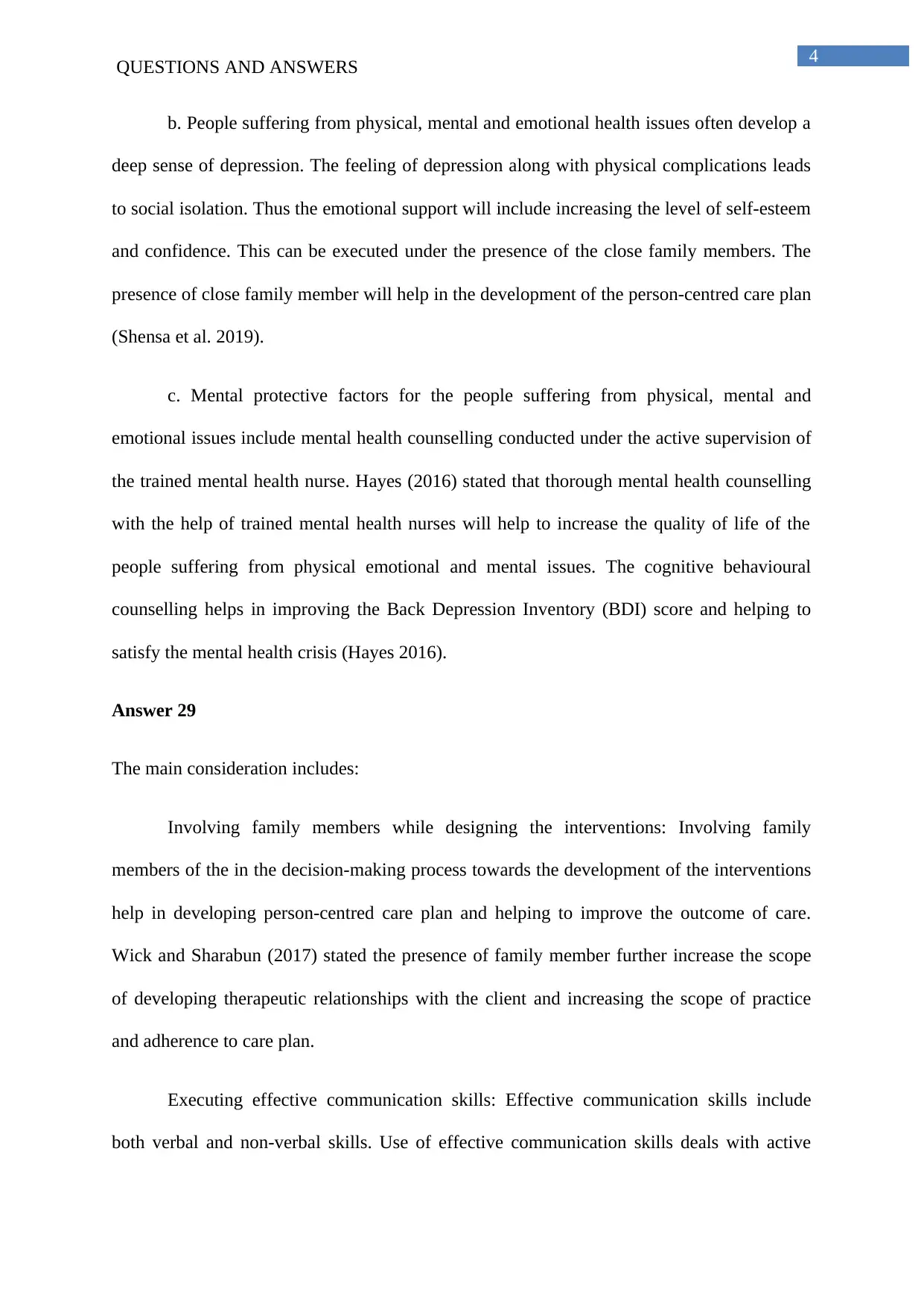
4
QUESTIONS AND ANSWERS
b. People suffering from physical, mental and emotional health issues often develop a
deep sense of depression. The feeling of depression along with physical complications leads
to social isolation. Thus the emotional support will include increasing the level of self-esteem
and confidence. This can be executed under the presence of the close family members. The
presence of close family member will help in the development of the person-centred care plan
(Shensa et al. 2019).
c. Mental protective factors for the people suffering from physical, mental and
emotional issues include mental health counselling conducted under the active supervision of
the trained mental health nurse. Hayes (2016) stated that thorough mental health counselling
with the help of trained mental health nurses will help to increase the quality of life of the
people suffering from physical emotional and mental issues. The cognitive behavioural
counselling helps in improving the Back Depression Inventory (BDI) score and helping to
satisfy the mental health crisis (Hayes 2016).
Answer 29
The main consideration includes:
Involving family members while designing the interventions: Involving family
members of the in the decision-making process towards the development of the interventions
help in developing person-centred care plan and helping to improve the outcome of care.
Wick and Sharabun (2017) stated the presence of family member further increase the scope
of developing therapeutic relationships with the client and increasing the scope of practice
and adherence to care plan.
Executing effective communication skills: Effective communication skills include
both verbal and non-verbal skills. Use of effective communication skills deals with active
QUESTIONS AND ANSWERS
b. People suffering from physical, mental and emotional health issues often develop a
deep sense of depression. The feeling of depression along with physical complications leads
to social isolation. Thus the emotional support will include increasing the level of self-esteem
and confidence. This can be executed under the presence of the close family members. The
presence of close family member will help in the development of the person-centred care plan
(Shensa et al. 2019).
c. Mental protective factors for the people suffering from physical, mental and
emotional issues include mental health counselling conducted under the active supervision of
the trained mental health nurse. Hayes (2016) stated that thorough mental health counselling
with the help of trained mental health nurses will help to increase the quality of life of the
people suffering from physical emotional and mental issues. The cognitive behavioural
counselling helps in improving the Back Depression Inventory (BDI) score and helping to
satisfy the mental health crisis (Hayes 2016).
Answer 29
The main consideration includes:
Involving family members while designing the interventions: Involving family
members of the in the decision-making process towards the development of the interventions
help in developing person-centred care plan and helping to improve the outcome of care.
Wick and Sharabun (2017) stated the presence of family member further increase the scope
of developing therapeutic relationships with the client and increasing the scope of practice
and adherence to care plan.
Executing effective communication skills: Effective communication skills include
both verbal and non-verbal skills. Use of effective communication skills deals with active
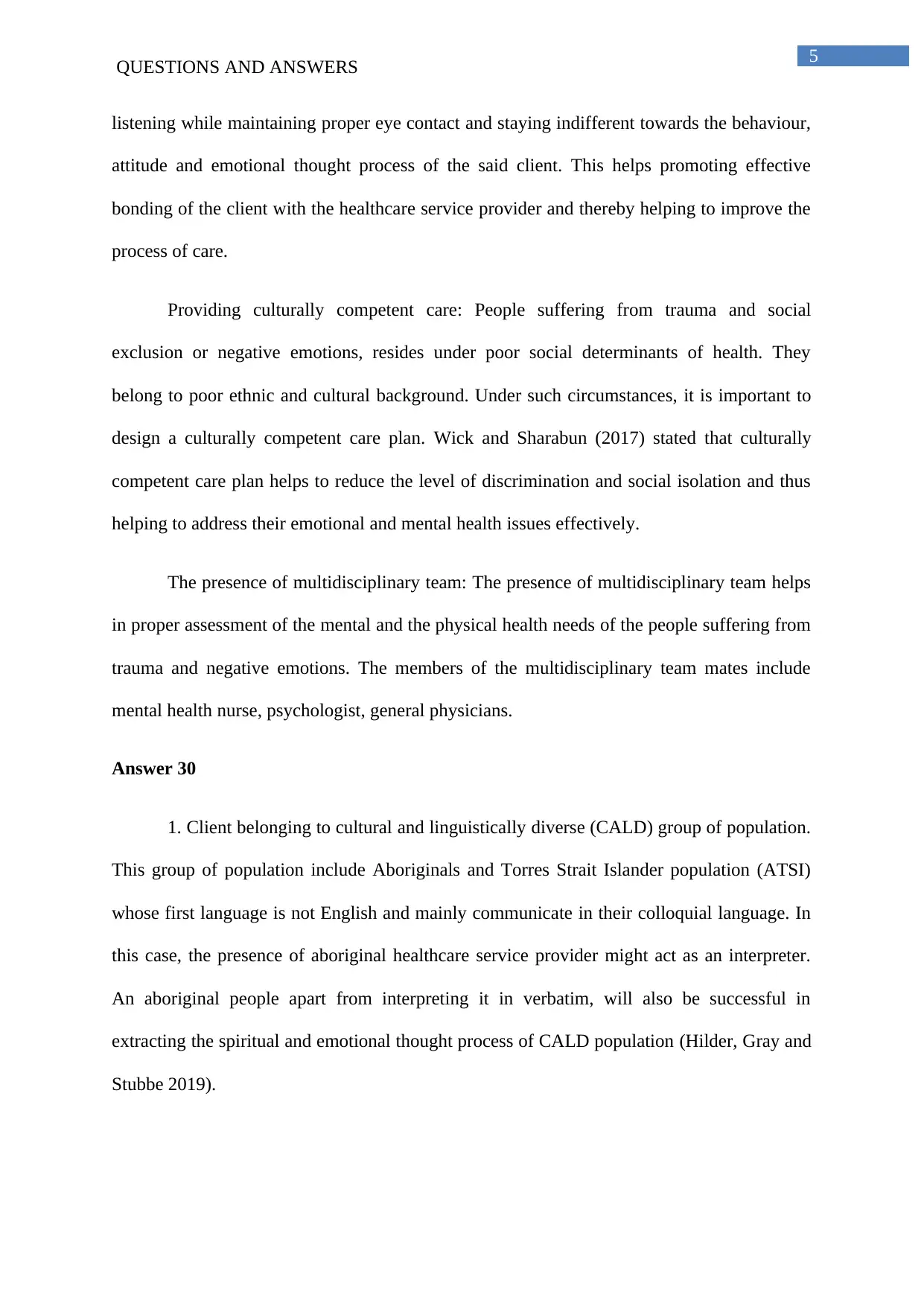
5
QUESTIONS AND ANSWERS
listening while maintaining proper eye contact and staying indifferent towards the behaviour,
attitude and emotional thought process of the said client. This helps promoting effective
bonding of the client with the healthcare service provider and thereby helping to improve the
process of care.
Providing culturally competent care: People suffering from trauma and social
exclusion or negative emotions, resides under poor social determinants of health. They
belong to poor ethnic and cultural background. Under such circumstances, it is important to
design a culturally competent care plan. Wick and Sharabun (2017) stated that culturally
competent care plan helps to reduce the level of discrimination and social isolation and thus
helping to address their emotional and mental health issues effectively.
The presence of multidisciplinary team: The presence of multidisciplinary team helps
in proper assessment of the mental and the physical health needs of the people suffering from
trauma and negative emotions. The members of the multidisciplinary team mates include
mental health nurse, psychologist, general physicians.
Answer 30
1. Client belonging to cultural and linguistically diverse (CALD) group of population.
This group of population include Aboriginals and Torres Strait Islander population (ATSI)
whose first language is not English and mainly communicate in their colloquial language. In
this case, the presence of aboriginal healthcare service provider might act as an interpreter.
An aboriginal people apart from interpreting it in verbatim, will also be successful in
extracting the spiritual and emotional thought process of CALD population (Hilder, Gray and
Stubbe 2019).
QUESTIONS AND ANSWERS
listening while maintaining proper eye contact and staying indifferent towards the behaviour,
attitude and emotional thought process of the said client. This helps promoting effective
bonding of the client with the healthcare service provider and thereby helping to improve the
process of care.
Providing culturally competent care: People suffering from trauma and social
exclusion or negative emotions, resides under poor social determinants of health. They
belong to poor ethnic and cultural background. Under such circumstances, it is important to
design a culturally competent care plan. Wick and Sharabun (2017) stated that culturally
competent care plan helps to reduce the level of discrimination and social isolation and thus
helping to address their emotional and mental health issues effectively.
The presence of multidisciplinary team: The presence of multidisciplinary team helps
in proper assessment of the mental and the physical health needs of the people suffering from
trauma and negative emotions. The members of the multidisciplinary team mates include
mental health nurse, psychologist, general physicians.
Answer 30
1. Client belonging to cultural and linguistically diverse (CALD) group of population.
This group of population include Aboriginals and Torres Strait Islander population (ATSI)
whose first language is not English and mainly communicate in their colloquial language. In
this case, the presence of aboriginal healthcare service provider might act as an interpreter.
An aboriginal people apart from interpreting it in verbatim, will also be successful in
extracting the spiritual and emotional thought process of CALD population (Hilder, Gray and
Stubbe 2019).
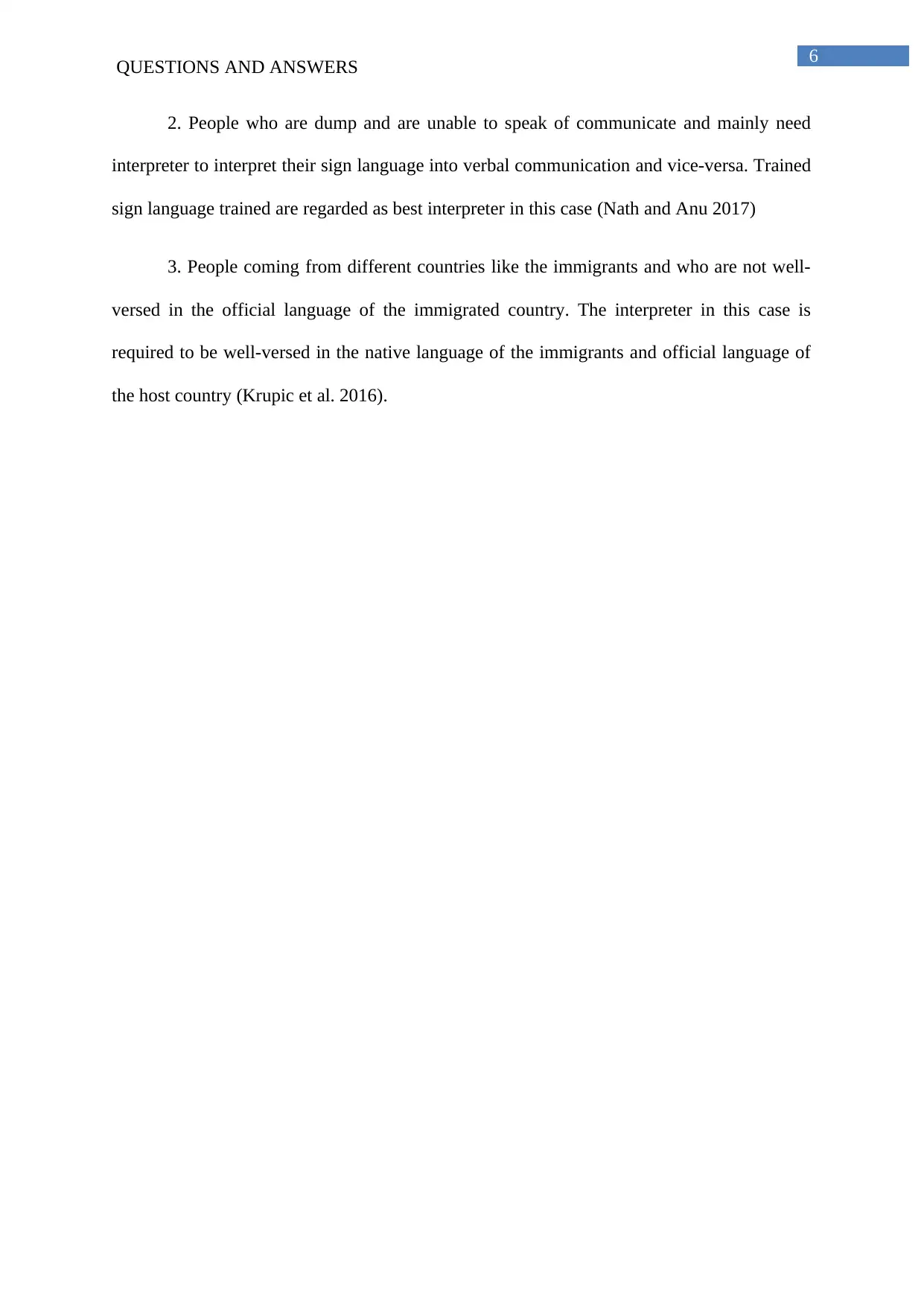
6
QUESTIONS AND ANSWERS
2. People who are dump and are unable to speak of communicate and mainly need
interpreter to interpret their sign language into verbal communication and vice-versa. Trained
sign language trained are regarded as best interpreter in this case (Nath and Anu 2017)
3. People coming from different countries like the immigrants and who are not well-
versed in the official language of the immigrated country. The interpreter in this case is
required to be well-versed in the native language of the immigrants and official language of
the host country (Krupic et al. 2016).
QUESTIONS AND ANSWERS
2. People who are dump and are unable to speak of communicate and mainly need
interpreter to interpret their sign language into verbal communication and vice-versa. Trained
sign language trained are regarded as best interpreter in this case (Nath and Anu 2017)
3. People coming from different countries like the immigrants and who are not well-
versed in the official language of the immigrated country. The interpreter in this case is
required to be well-versed in the native language of the immigrants and official language of
the host country (Krupic et al. 2016).
Paraphrase This Document
Need a fresh take? Get an instant paraphrase of this document with our AI Paraphraser
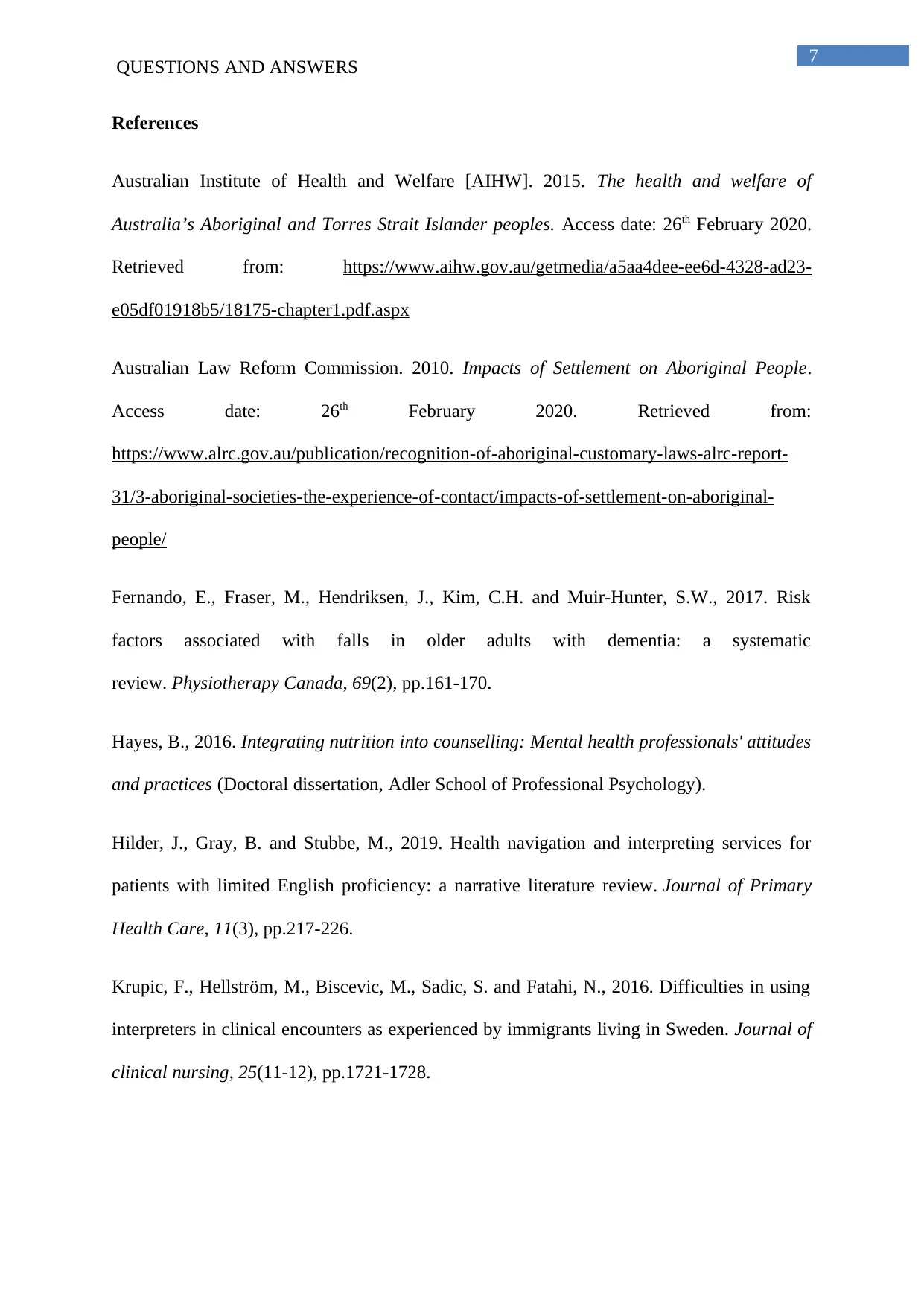
7
QUESTIONS AND ANSWERS
References
Australian Institute of Health and Welfare [AIHW]. 2015. The health and welfare of
Australia’s Aboriginal and Torres Strait Islander peoples. Access date: 26th February 2020.
Retrieved from: https://www.aihw.gov.au/getmedia/a5aa4dee-ee6d-4328-ad23-
e05df01918b5/18175-chapter1.pdf.aspx
Australian Law Reform Commission. 2010. Impacts of Settlement on Aboriginal People.
Access date: 26th February 2020. Retrieved from:
https://www.alrc.gov.au/publication/recognition-of-aboriginal-customary-laws-alrc-report-
31/3-aboriginal-societies-the-experience-of-contact/impacts-of-settlement-on-aboriginal-
people/
Fernando, E., Fraser, M., Hendriksen, J., Kim, C.H. and Muir-Hunter, S.W., 2017. Risk
factors associated with falls in older adults with dementia: a systematic
review. Physiotherapy Canada, 69(2), pp.161-170.
Hayes, B., 2016. Integrating nutrition into counselling: Mental health professionals' attitudes
and practices (Doctoral dissertation, Adler School of Professional Psychology).
Hilder, J., Gray, B. and Stubbe, M., 2019. Health navigation and interpreting services for
patients with limited English proficiency: a narrative literature review. Journal of Primary
Health Care, 11(3), pp.217-226.
Krupic, F., Hellström, M., Biscevic, M., Sadic, S. and Fatahi, N., 2016. Difficulties in using
interpreters in clinical encounters as experienced by immigrants living in Sweden. Journal of
clinical nursing, 25(11-12), pp.1721-1728.
QUESTIONS AND ANSWERS
References
Australian Institute of Health and Welfare [AIHW]. 2015. The health and welfare of
Australia’s Aboriginal and Torres Strait Islander peoples. Access date: 26th February 2020.
Retrieved from: https://www.aihw.gov.au/getmedia/a5aa4dee-ee6d-4328-ad23-
e05df01918b5/18175-chapter1.pdf.aspx
Australian Law Reform Commission. 2010. Impacts of Settlement on Aboriginal People.
Access date: 26th February 2020. Retrieved from:
https://www.alrc.gov.au/publication/recognition-of-aboriginal-customary-laws-alrc-report-
31/3-aboriginal-societies-the-experience-of-contact/impacts-of-settlement-on-aboriginal-
people/
Fernando, E., Fraser, M., Hendriksen, J., Kim, C.H. and Muir-Hunter, S.W., 2017. Risk
factors associated with falls in older adults with dementia: a systematic
review. Physiotherapy Canada, 69(2), pp.161-170.
Hayes, B., 2016. Integrating nutrition into counselling: Mental health professionals' attitudes
and practices (Doctoral dissertation, Adler School of Professional Psychology).
Hilder, J., Gray, B. and Stubbe, M., 2019. Health navigation and interpreting services for
patients with limited English proficiency: a narrative literature review. Journal of Primary
Health Care, 11(3), pp.217-226.
Krupic, F., Hellström, M., Biscevic, M., Sadic, S. and Fatahi, N., 2016. Difficulties in using
interpreters in clinical encounters as experienced by immigrants living in Sweden. Journal of
clinical nursing, 25(11-12), pp.1721-1728.
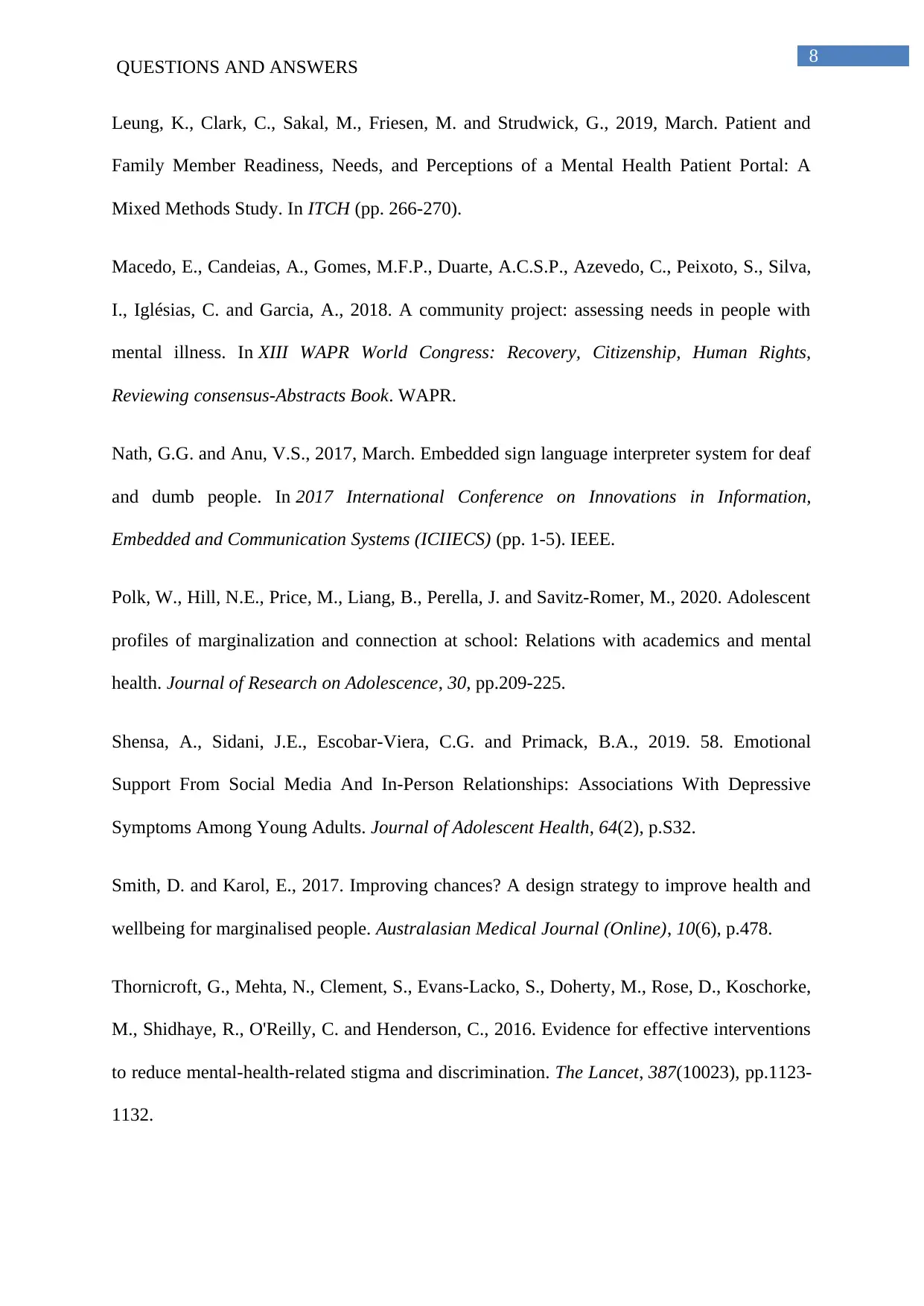
8
QUESTIONS AND ANSWERS
Leung, K., Clark, C., Sakal, M., Friesen, M. and Strudwick, G., 2019, March. Patient and
Family Member Readiness, Needs, and Perceptions of a Mental Health Patient Portal: A
Mixed Methods Study. In ITCH (pp. 266-270).
Macedo, E., Candeias, A., Gomes, M.F.P., Duarte, A.C.S.P., Azevedo, C., Peixoto, S., Silva,
I., Iglésias, C. and Garcia, A., 2018. A community project: assessing needs in people with
mental illness. In XIII WAPR World Congress: Recovery, Citizenship, Human Rights,
Reviewing consensus-Abstracts Book. WAPR.
Nath, G.G. and Anu, V.S., 2017, March. Embedded sign language interpreter system for deaf
and dumb people. In 2017 International Conference on Innovations in Information,
Embedded and Communication Systems (ICIIECS) (pp. 1-5). IEEE.
Polk, W., Hill, N.E., Price, M., Liang, B., Perella, J. and Savitz‐Romer, M., 2020. Adolescent
profiles of marginalization and connection at school: Relations with academics and mental
health. Journal of Research on Adolescence, 30, pp.209-225.
Shensa, A., Sidani, J.E., Escobar-Viera, C.G. and Primack, B.A., 2019. 58. Emotional
Support From Social Media And In-Person Relationships: Associations With Depressive
Symptoms Among Young Adults. Journal of Adolescent Health, 64(2), p.S32.
Smith, D. and Karol, E., 2017. Improving chances? A design strategy to improve health and
wellbeing for marginalised people. Australasian Medical Journal (Online), 10(6), p.478.
Thornicroft, G., Mehta, N., Clement, S., Evans-Lacko, S., Doherty, M., Rose, D., Koschorke,
M., Shidhaye, R., O'Reilly, C. and Henderson, C., 2016. Evidence for effective interventions
to reduce mental-health-related stigma and discrimination. The Lancet, 387(10023), pp.1123-
1132.
QUESTIONS AND ANSWERS
Leung, K., Clark, C., Sakal, M., Friesen, M. and Strudwick, G., 2019, March. Patient and
Family Member Readiness, Needs, and Perceptions of a Mental Health Patient Portal: A
Mixed Methods Study. In ITCH (pp. 266-270).
Macedo, E., Candeias, A., Gomes, M.F.P., Duarte, A.C.S.P., Azevedo, C., Peixoto, S., Silva,
I., Iglésias, C. and Garcia, A., 2018. A community project: assessing needs in people with
mental illness. In XIII WAPR World Congress: Recovery, Citizenship, Human Rights,
Reviewing consensus-Abstracts Book. WAPR.
Nath, G.G. and Anu, V.S., 2017, March. Embedded sign language interpreter system for deaf
and dumb people. In 2017 International Conference on Innovations in Information,
Embedded and Communication Systems (ICIIECS) (pp. 1-5). IEEE.
Polk, W., Hill, N.E., Price, M., Liang, B., Perella, J. and Savitz‐Romer, M., 2020. Adolescent
profiles of marginalization and connection at school: Relations with academics and mental
health. Journal of Research on Adolescence, 30, pp.209-225.
Shensa, A., Sidani, J.E., Escobar-Viera, C.G. and Primack, B.A., 2019. 58. Emotional
Support From Social Media And In-Person Relationships: Associations With Depressive
Symptoms Among Young Adults. Journal of Adolescent Health, 64(2), p.S32.
Smith, D. and Karol, E., 2017. Improving chances? A design strategy to improve health and
wellbeing for marginalised people. Australasian Medical Journal (Online), 10(6), p.478.
Thornicroft, G., Mehta, N., Clement, S., Evans-Lacko, S., Doherty, M., Rose, D., Koschorke,
M., Shidhaye, R., O'Reilly, C. and Henderson, C., 2016. Evidence for effective interventions
to reduce mental-health-related stigma and discrimination. The Lancet, 387(10023), pp.1123-
1132.

9
QUESTIONS AND ANSWERS
Wick, J.Y. and Sharabun, M., 2017. Long-Term Care and Cultural Competence. The
Consultant Pharmacist®, 32(1), pp.12-21.
Working with Indigenous Australians. 2017. Initial invasion and colonisation (1788 to 1890).
Access date: 26th February 2020. Retrieved from:
http://www.workingwithindigenousaustralians.info/content/History_3_Colonisation.html
QUESTIONS AND ANSWERS
Wick, J.Y. and Sharabun, M., 2017. Long-Term Care and Cultural Competence. The
Consultant Pharmacist®, 32(1), pp.12-21.
Working with Indigenous Australians. 2017. Initial invasion and colonisation (1788 to 1890).
Access date: 26th February 2020. Retrieved from:
http://www.workingwithindigenousaustralians.info/content/History_3_Colonisation.html
1 out of 10
Related Documents
Your All-in-One AI-Powered Toolkit for Academic Success.
+13062052269
info@desklib.com
Available 24*7 on WhatsApp / Email
![[object Object]](/_next/static/media/star-bottom.7253800d.svg)
Unlock your academic potential
© 2024 | Zucol Services PVT LTD | All rights reserved.





